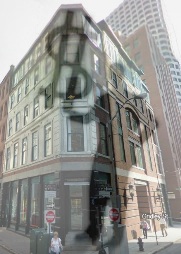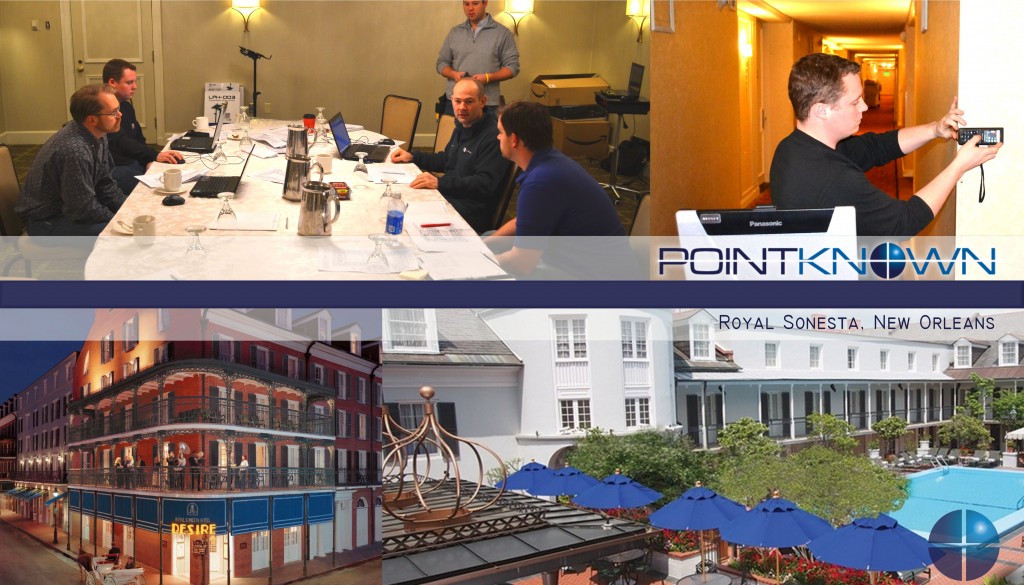Posts Tagged Building
What Owners Need to Know When Documenting Existing Buildings ….Part II
Posted by Jim Foster in BIM, Built Environment on September 4, 2014

I recently was invited to present for an IFMA Technology Council Webinar (Link to Deck Here). Both Carlos Vasquez from Epic Scan, the other presenter , and myself had come both mostly to the same conclusions having never met and working on two different coasts. “It really is the wild west out there.” For instance, there are no standards on deliverables or when putting out an RFP for this kind of work. Plus, there are a lot of people out there buying scanners and saying they can do everything that comes in the literature with the hardware. However, owning a piece of hardware and being competent at it are two vastly different things. Just because I own a pair of skates doesn’t mean I can get on the ice with the Rangers. Plus, if the firm you are hiring only has one piece of hardware expect that the quote you get will be one size fits all.
My approach to any given job is to have a detailed conversation with whoever is going to use the Revit Model or Data and what they need it for. For example, an owner doing due diligence on a property has vastly different need and budget then an architectural firm doing an adaptive reuse project on 200,000 SF of Industrial Mill Space. So we tailor the project and technology around their needs and budget. I would argue that an owner look at each project and start with the minimal viable product (MVP) or data set they need and then add details as the project warrants. With that said the base line product should still be solid. For example, we might be asked to come in to verify square footages of a building during due diligence. This is to make certain that the prospective owner has faith that the marketed 100,000 SF actually is 100,000 SF of rentable space. This might just require us to get the shell and cores correctly. But be certain that is done well enough so if going forward we need to add the mechanical plant, or interior partitioning, etc. we have a good foundation to start from.
If you are looking to document your building for almost any stage, due diligence, BOMA calculations, Interior Design, Adaptive Reuse there are a couple of things to keep in mind.
• Size and Complexity of the Project
• Interior/Exterior
• Deadlines and Time Constraints
• Budget and Available Resources
• Uses for Models
and when choosing a vendor or service provider…get references, see if they have done similar projects, ask them about their process and their technology. When done right having a model or your building documented properly, accurately pays dividends many times over, when done wrong it has Excedrin written all over it.
5 Firms Converge on New Orleans to Document The Royal Sonesta
Posted by Jim Foster in 3D, As Builts, BIM, Built Environment, Existing Conditions on January 16, 2013
 “Jim your a go….” 2:40 PM, New Years Eve 2012. Text from our client; Mark at Looney & Associates
“Jim your a go….” 2:40 PM, New Years Eve 2012. Text from our client; Mark at Looney & Associates
Our work window was January 3rd through January 9 2013. Travel arrangements and team needed to be assembled for flights in two days. The only thread holding this together was PKNail Pro.
Team members included individuals from Langan Engineering, Turis, TrueScan3d, LandAir Surveying and my company Interioreview. The Job: Survey and Document Floors 2-7 of the Royal Sonesta Hotel, 300 Bourbon Street. Include structure, electrical objects (Duplex, Com Ports, Thermostats, Wall Lights, etc) and Fire Protection. 450+ Rooms, Common Spaces, Administrative Spaces, +200,000 SF. 1 Week. From Blank Screen to Floorplans and RCP.
“This is innovative stuff…”, Greg Jensen, Langan Engineering
“…Boom, your done.” Brady O’Brien, Turis Systems
“This certainly opens the door for future teaming efforts, and we’ve already begun to push PK Nail on some of our interior projects – integrating it with scanning and traditional survey.” – Paul Fisher, VP Langan Engineering.
This project could not have happened without the participating firms willingness to deal with such a tight deployment deadline and with the excellent individuals that arrived in New Orleans. It also could not have happened, and I do have a horse in this race, without PKNail Pro and Revit. There was simply no other way to coordinate multiple personnel field surveying without both. We were able to deploy resources as needed since everything was being surveyed and modeled in real time. 4th Floor, South Wing, Greg get on it. Brian, 2nd Floor with Nico etc. This also allowed us to create a punch list in real time. Reflected Ceiling on 3rd Floor, etc. as all the files were compiled daily, if not more often into a central file. Although the deliverable will eventually be in 2D Autocad, all the initial documentation will be in Revit, so even though it was not part of the scope, we will be able to deliver a typical section through the building with only a small post processing effort.
Lastly, thank you to the good folks at The Royal Sonesta, New Orleans for treating us so well. They understand hospitality and have a great team.
More and more firms are relying on PKNail Pro for documenting buildings whether they need the final deliverable in Revit or 2D Autocad. PKNail Pro can deliver.
Current Technologies for Reality Capture : #Revit #BIM #AU2011
Posted by Jim Foster in BIM, Built Environment, New Technologies on December 14, 2011
 I was at the recent Autodesk University in Las Vegas and sat in the session for Reality Capture for Rapid Energy Modeling by Jess Miller who discussed the current technologies and work flows to document existing buildings digitally in Revit. As it stands the 4 available today are:
I was at the recent Autodesk University in Las Vegas and sat in the session for Reality Capture for Rapid Energy Modeling by Jess Miller who discussed the current technologies and work flows to document existing buildings digitally in Revit. As it stands the 4 available today are:
- Satellite Imagery
- Laser Scanning
- 123D Catch (aka Photofly)
- PKNail Pro
All of these technologies with the exception of PKNail, yes I do have a horse in this race, require a user to extract geometry from one program and draft in another. PKNail allows a user to survey and model directly in Revit. However, the most important task is choosing the right tool for the job and usually this is driven by the scope of the project/deliverable, what the model is going to be used for, and conditions and access of the building. First, let’s look briefly at the current technologies and how they work.
Satellite Imagery
this requires getting oblique images from a source such as bing maps or Pictometry, that then can then be scaled and traced over in Revit. While it could be the least expensive of the methods it is generally a lot less accurate, requires something that allows you to scale the photos properly either on site measurements, existing plot plan, or CAD floor plan and any real details will not be included. This might prove to be an okay method to extract geometry for energy modeling but the model would end there, you could not use it to move forward with an architectural model. Additionally, it requires a sophisticated users knowledge of Revit through linking photos and extracting geometry.
Laser Scanning.
This is generally done as a service, that is you hire a company who has a laser scanner to create a pointcloud of the building you need. Estimates range from $3-$5K per day to have someone scanning a building. I know from experience that I have been quoted almost $60,000 to scan the exterior and interior of a single story industrial building and that did not include the Revit model we needed. We would have to build that ourselves from the point cloud. However, if you need an accurate 3D data set of an existing structure it is an excellent resource. You will need to import the pointcloud into Revit and trace over it to create the geometry making it at least a 2 step process. There are some technologies available such as Imaganit from Rand Technologies that will allow a user to extract some geometry to Revit but it is still a manual process. I have seen excellent use of this technology is extensive exposed MEP projects, think boiler room or oil rig, or difficult and inaccessible geometry, such as the Capitol Dome.
123D Catch,
is a program that allows you take pictures of building, send them up into the cloud and have them stitched together and served back to you as a 3D Photo model that you can then scale and extract geometry from. I have not had success using this product. I want to be successful using this product because I think it would be awesome but the few times I have sent something up to the could I get back something that looks like I am looking through a kaleidoscope. I highly recommend you take a look because as the technology progresses and computers get more powerful this will only get better.
PKNail Pro for Revit,
this is an add in to Revit that allows you to create real Revit objects, driven wirelessly from laser range finder (Disto D8) and from measurements in the field. That is measure wall, press a button and the wall is created directly in Revit. This is the only software that works within the actual BIM software so there is no need to translate or extract geometry. PKNail Pro automates current workflows and data capture and allows a user to finish the model on site. It excels at creating dimensionally correct 3D models of the both the interior and exterior. However, if you need a lot of exterior detail you may want to pair it with another of the technologies to create gutter sweeps, cornice work, etc. if that is needed on the project. PKNail also recognizes any Revit wall so you could another technology/method to create the exterior and use PKNail Pro to capture all the interior fit outs.
What it boils down to is what is needed based on the scope of the project and your budget. Choose the right tool for the job and don’t limit yourself, because who wants to use a hammer when you need a screw driver, or use a jackhammer when you need to hang a picture. I’ll work on my metaphors, you work on capturing reality.
Financing coming together for Green Building Initiatives : Consortium put together by The Carbon War Room
Posted by Jim Foster in Built Environment, Green on September 20, 2011
 So you want to retrofit a building. Everything is in place, the ROI calculations, the press for promoting your green building, possibly higher SF Lease Rates because of the Green Building, plus you’ll be saving money from it, less green house gases, less dependence on fossil fuel, etc. The one thing missing, no matter how much it makes sense, the financing. Excellent article in the NY Times, Tax Plan to Turn Old Buildings ‘Green’ Finds Favor, explaining the current model which would be in the form of bonds sold to investors. “The consortium was put together by the Carbon War Room, a nonprofit environmental group based in Washington set up by Richard Branson, the British entrepreneur”, what doesn’t this guy do.
So you want to retrofit a building. Everything is in place, the ROI calculations, the press for promoting your green building, possibly higher SF Lease Rates because of the Green Building, plus you’ll be saving money from it, less green house gases, less dependence on fossil fuel, etc. The one thing missing, no matter how much it makes sense, the financing. Excellent article in the NY Times, Tax Plan to Turn Old Buildings ‘Green’ Finds Favor, explaining the current model which would be in the form of bonds sold to investors. “The consortium was put together by the Carbon War Room, a nonprofit environmental group based in Washington set up by Richard Branson, the British entrepreneur”, what doesn’t this guy do.
As excerpted from the Article:
Short-term loans provided by Barclays Capital will be used to pay for the upgrades. Contractors will offer a warranty that the utility savings they have promised will actually materialize, and an insurance underwriter, Energi, of Peabody, Mass., will back up that warranty. Those insurance contracts, in turn, will be backed by Hannover Re, one of the world’s largest reinsurance companies.
As projects are completed, the upgrade loans, typically carrying interest rates of 7 percent, will be bundled into long-term bonds resembling those routinely issued by governmental taxing districts. Barclays will market the bonds. Retirement funds have expressed interest in buying these bonds, which will be repaid by tax surcharges on each property that undergoes a retrofit.
This all is just starting to make too much sense.

